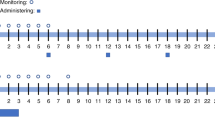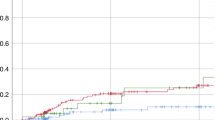Abstract
In order to control busulfan pharmacokinetic variability and toxicity, a specific monitoring protocol was instituted in our bone marrow transplant BMT paediatric patients including a test dose, daily Bayesian forecasting of busulfan plasma levels, and Bayesian individualization of busulfan dosage regimens. Twenty-nine children received BMT after a busulfan-based conditioning regimen. Individual pharmacokinetic parameters were obtained following a 0.5 mg*kg test dose and were used for daily individualization of dosage regimens during the subsequent 4-day course of treatment. Doses were adjusted to reach a target mean AUC per 6 h between 4 and 6 μg.h.ml+1. Plasma busulfan assays were performed by liquid chromatography. Pharmacokinetic analysis used the USC*PACK software. The performance of the test dose to predict AUC during the busulfan regimen was evaluated. Incidence of toxicity, chimerism and relapse, overall Kaplan–Meier survival, and VOD-free survival were compared after matching our patients (group A) with patients conditioned by using standard doses of busulfan (group B). Busulfan doses were decreased in 69% of patients compared to conventional doses. Expected AUC was significantly correlated with observed AUC and predictability of the test dose was 101.9 ± 17.9%. Incidence of VOD in group A was 3.4% vs 24.1% in group B, while the incidence of stomatitis was similar. Engraftment was successful in all patients in group A. The rate of full engraftment at 3 months post-BMT was higher in group A (P = 0.012). Long-term overall survival did not differ between the two groups, in contrast to the 90-day survival. VOD-free survival was higher in group A (P = 0.026). Pharmacokinetic monitoring and individualization of busulfan dosage regimen are useful in improving clinical outcome and reducing early mortality in paediatric bone marrow transplant recipients. Bone Marrow Transplantation (2001) 28, 743–751.
This is a preview of subscription content, access via your institution
Access options
Subscribe to this journal
Receive 12 print issues and online access
$259.00 per year
only $21.58 per issue
Buy this article
- Purchase on Springer Link
- Instant access to full article PDF
Prices may be subject to local taxes which are calculated during checkout


Similar content being viewed by others
References
Parkman R, Rappeport JM, Hellman S et al. Busulfan and total body irradiation as anti-haemopoietic stem cell agents in the preparation of patients with congenital bone marrow disorders for allogeneic bone marrow transplantation Blood 1984 64: 852–857
Styler MJ, Crilley P, Biggs J et al. Hepatic dysfunction following busulfan and cyclophosphamide myeloablation: a retrospective, multicenter analysis Bone Marrow Transplant 1996 18: 171–176
Morris JD, Harris RE, Hashmi R et al. Antithrombine III for the treatment of chemotherapy induced organ dysfunction following bone marrow transplantation Bone Marrow Transplant 1997 20: 871–878
Hartman AR, Williams SF, Dillon JJ . Survival, disease-free survival and adverse effects of conditioning for allogeneic bone marrow transplantation with busulfan/cyclophosphamide versus total body irradiation: a meta-analysis Bone Marrow Transplant 1998 22: 439–443
Comcowich SA, Spitzer TR, Tsunoda SM . Ursodiol to prevent hepatic veno-occlusive disease Ann Pharmacother 1997 31: 1249–1252
Rozman C, Carreras E, Qian C et al. Risk factors for hepatic veno-occlusive disease following HLA-identical sibling bone marrow transplants for leukemia Bone Marrow Transplant 1996 17: 75–80
Baglin TP . Veno-occlusive disease of the liver complicating bone marrow transplantation Bone Marrow Transplant 1994 13: 1–4
Slattery JT, Sanders JE, Buckner CD et al. Graft-rejection and toxicity following bone marrow transplantation in relation to busulfan pharmacokinetics Bone Marrow Transplant 1995 16: 31–42
Dix SP, Wingard JR, Mullins RE et al. Association of busulfan area under the curve with veno-occlusive disease following BMT Bone Marrow Transplant 1996 17: 225–230
Hassan M, Fasth A, Gerritsen B et al. Busulphan kinetics and limited sampling model in children with leukemia and inherited disorders Bone Marrow Transplant 1996 18: 843–850
Chattergoon DS, Saunders EF, Klein J et al. An improved limited sampling method for individualised busulphan dosing in bone marrow transplantation in children Bone Marrow Transplant 1997 20: 347–354
Slattery JT, Risler LJ . Therapeutic monitoring of busulfan in hematopoietic stem cell transplantation Ther Drug Monit 1998 20: 543–554
Grochow LB, Jones RJ, Brundrett RB . Pharmacokinetics of busulfan: correlation with veno-occlusive disease in patients undergoing bone marrow transplantation Cancer Chemother Pharmacol 1989 25: 55–61
Tran HT, Madden T, Petropoulos D et al. Individualizing high-dose oral busulfan: prospective dose adjustment in a pediatric population undergoing allogeneic stem cell transplantation for advanced hematologic malignancies Bone Marrow Transplant 2000 26: 463–470
Hassan M, Oberg G, Bekassy AN et al. Pharmacokinetics of high-dose busulphan in relation to age and chronopharmacology Cancer Chemother Pharmacol 1991 28: 130–134
Gibbs JP, Murray G, Risler L et al. Age-dependent tetrahydrothiophenium ion formation in young children and adults receiving high-dose busulfan Cancer Res 1996 56: 3678–3681
Vassal G, Deroussent A, Challine D et al. Is 600 mg/m2 the appropriate dosage of busulfan in children undergoing bone marrow transplantation? Blood 1992 79: 2475–2479
Jelliffe RW, Schumitzky A, Van Guilder M et al. Individualizing drug dosage regimens: roles of population and pharmacodynamic models, bayesian fitting, and adaptive control Ther Drug Monit 1993 15: 380–393
Bleyzac N, Barou P, Aulagner G . Rapid and sensitive high-performace liquid chromatographic method for busulfan assay in plasma J Chromatogr Biomed Appl 2000 742: 427–432
D'Argenio DZ . Optimal sampling times for pharmacokinetic experiments J Pharmacokin Biopharm 1981 9: 739–756
Tod M, Mentre F, Merle Y, Mallet A . Robust design for the estimation on hyperparameters in population pharmacokinetics J Pharmacokin Biopharm 1998 26: 689–711
Laboratory of Applied Pharmacokinetics. USC*Pack P.C. Collection Clinical Research Programs, Los Angeles. University of Southern California, School of Medicine, 1995, version 10.7
Bleyzac N, Barou P, Massenavette B et al. Assessment of acyclovir intraindividual pharmacokinetic variability during continuous hemofiltration, continuous hemodiafiltration and continuous hemodialysis Ther Drug Monit 1999 21: 520–525
Jeffreys AJ, Wilson W, Neimann R, Keyte J . Amplification of human minisatellites by the PCR: toward fingerprinting of single cells Nucleic Acid Res 1988 16: 10953–10971
Baker KS, Bostrom B, DeFor T et al. Busulfan pharmacokinetics do not predict relapse in acute myeloid leukemia Bone Marrow Transplant 2000 26: 607–614
Li CK, Yuen PMP, Wong R et al. Busulphan level and early mortality in thalassemia patients after BMT Bone Marrow Transplant 1999 23: 307–310
Bolinger AM, Zangwill AB, Slattery JT et al. An evaluation of engraftment, toxicity and busulfan concentration in children receiving bone marrow transplantation for leukemia or genetic disease Bone Marrow Transplant 2000 25: 925–930
Magron P, Bleyzac N, Souillet G et al. Control of intra- and inter-patient variability by Bayesian forecasting of busulfan dosage regimens in pediatric BMT Pediat Res 1999 45: 769 (Abstr.)
Cordonnier C, Chevret S, Legrand M et al. IVIG prophylaxis in allogeneic sibling SCT: preliminary results of a randomized dose-effect, placebo-controlled, double-blind, multicenter trial 27th Annual Meeting of European Group for Blood and Marrow Transplantation, Maastricht 2001
Choi SJ, Lee KH, Lee JH et al. Prognostic value of hematopoietic chimerism in patients with acute leukemia after allogeneic bone marrow transplantation: a prospective study Bone Marrow Transplant 2000 26: 327–332
Acknowledgements
This work was supported by a grant from Hospices Civils de Lyon, 3 Quai des Célestins, 69002 Lyon, and by the association ‘LE DEFI ANTHONY’, Mont Talon, 71800 St Symphorien des Bois, France.
Author information
Authors and Affiliations
Rights and permissions
About this article
Cite this article
Bleyzac, N., Souillet, G., Magron, P. et al. Improved clinical outcome of paediatric bone marrow recipients using a test dose and Bayesian pharmacokinetic individualization of busulfan dosage regimens. Bone Marrow Transplant 28, 743–751 (2001). https://doi.org/10.1038/sj.bmt.1703207
Received:
Accepted:
Published:
Issue Date:
DOI: https://doi.org/10.1038/sj.bmt.1703207
Keywords
This article is cited by
-
Impact of busulfan pharmacokinetics on outcome in adult patients receiving an allogeneic hematopoietic cell transplantation
Bone Marrow Transplantation (2022)
-
Evaluation of two software using Bayesian methods for monitoring exposure and dosing once-daily intravenous busulfan in paediatric patients receiving haematopoietic stem cell transplantation
Cancer Chemotherapy and Pharmacology (2021)
-
Busulfan-cyclophosphamide versus cyclophosphamide-busulfan as conditioning regimen before allogeneic hematopoietic cell transplantation: a prospective randomized trial
Annals of Hematology (2021)
-
Intra-individual Pharmacokinetic Variability of Intravenous Busulfan in Hematopoietic Stem Cell-Transplanted Children
Clinical Pharmacokinetics (2020)
-
Population pharmacokinetics of busulfan in Saudi pediatric patients undergoing hematopoietic stem cell transplantation
International Journal of Clinical Pharmacy (2020)



